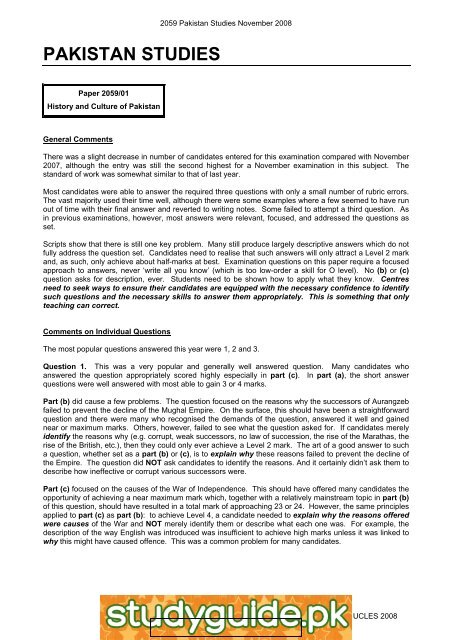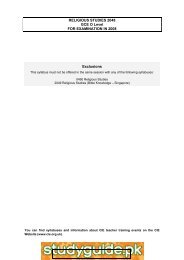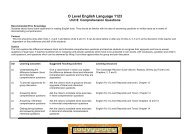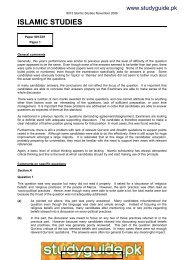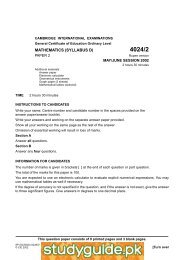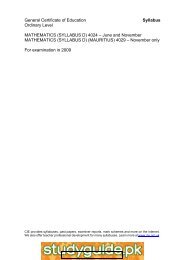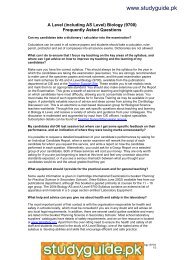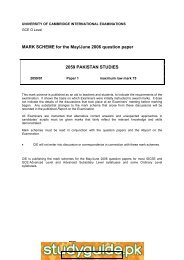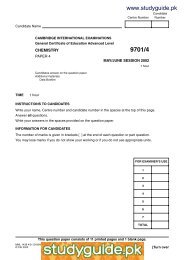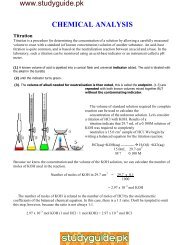PAKISTAN STUDIES www.xtremepapers.net - StudyGuide.PK
PAKISTAN STUDIES www.xtremepapers.net - StudyGuide.PK
PAKISTAN STUDIES www.xtremepapers.net - StudyGuide.PK
You also want an ePaper? Increase the reach of your titles
YUMPU automatically turns print PDFs into web optimized ePapers that Google loves.
1 © UCLES 2008<br />
<strong>www</strong>.<strong>xtremepapers</strong>.<strong>net</strong><br />
<strong>PAKISTAN</strong> <strong>STUDIES</strong><br />
2059 Pakistan Studies November 2008<br />
Paper 2059/01<br />
History and Culture of Pakistan<br />
General Comments<br />
There was a slight decrease in number of candidates entered for this examination compared with November<br />
2007, although the entry was still the second highest for a November examination in this subject. The<br />
standard of work was somewhat similar to that of last year.<br />
Most candidates were able to answer the required three questions with only a small number of rubric errors.<br />
The vast majority used their time well, although there were some examples where a few seemed to have run<br />
out of time with their final answer and reverted to writing notes. Some failed to attempt a third question. As<br />
in previous examinations, however, most answers were relevant, focused, and addressed the questions as<br />
set.<br />
Scripts show that there is still one key problem. Many still produce largely descriptive answers which do not<br />
fully address the question set. Candidates need to realise that such answers will only attract a Level 2 mark<br />
and, as such, only achieve about half-marks at best. Examination questions on this paper require a focused<br />
approach to answers, never ‘write all you know’ (which is too low-order a skill for O level). No (b) or (c)<br />
question asks for description, ever. Students need to be shown how to apply what they know. Centres<br />
need to seek ways to ensure their candidates are equipped with the necessary confidence to identify<br />
such questions and the necessary skills to answer them appropriately. This is something that only<br />
teaching can correct.<br />
Comments on Individual Questions<br />
The most popular questions answered this year were 1, 2 and 3.<br />
Question 1. This was a very popular and generally well answered question. Many candidates who<br />
answered the question appropriately scored highly especially in part (c). In part (a), the short answer<br />
questions were well answered with most able to gain 3 or 4 marks.<br />
Part (b) did cause a few problems. The question focused on the reasons why the successors of Aurangzeb<br />
failed to prevent the decline of the Mughal Empire. On the surface, this should have been a straightforward<br />
question and there were many who recognised the demands of the question, answered it well and gained<br />
near or maximum marks. Others, however, failed to see what the question asked for. If candidates merely<br />
identify the reasons why (e.g. corrupt, weak successors, no law of succession, the rise of the Marathas, the<br />
rise of the British, etc.), then they could only ever achieve a Level 2 mark. The art of a good answer to such<br />
a question, whether set as a part (b) or (c), is to explain why these reasons failed to prevent the decline of<br />
the Empire. The question did NOT ask candidates to identify the reasons. And it certainly didn’t ask them to<br />
describe how ineffective or corrupt various successors were.<br />
Part (c) focused on the causes of the War of Independence. This should have offered many candidates the<br />
opportunity of achieving a near maximum mark which, together with a relatively mainstream topic in part (b)<br />
of this question, should have resulted in a total mark of approaching 23 or 24. However, the same principles<br />
applied to part (c) as part (b): to achieve Level 4, a candidate needed to explain why the reasons offered<br />
were causes of the War and NOT merely identify them or describe what each one was. For example, the<br />
description of the way English was introduced was insufficient to achieve high marks unless it was linked to<br />
why this might have caused offence. This was a common problem for many candidates.
2 © UCLES 2008<br />
<strong>www</strong>.<strong>xtremepapers</strong>.<strong>net</strong><br />
2059 Pakistan Studies November 2008<br />
Question 2. This was also very popular. Most were able to score 2 or 3 marks in part (a).<br />
In part (b), candidates were required to explain why Congress opposed the Morley-Minto Reforms of 1909.<br />
Many responses were good and candidates clearly knew their facts. However, some candidates struggled to<br />
explain the importance of separate electorates and self-rule to opposition. As a result, many struggled to<br />
reach a good Level 3 mark.<br />
Part (c), like Question 1 (c) saw many fail to explain their answers sufficiently. This question focused on the<br />
reasons why the Khilafat Movement failed. For those who had adequately prepared for the examination, this<br />
question caused few problems. Answers from these candidates were focused, accurate and relevant - and<br />
many scored high Level 4. However, as in Question 1 (c), many merely described the Movement from<br />
beginning to end. Merely describing the Hijrat was NOT answering the question – only identifying/describing<br />
a reason met the requirements. In order to gain a Level 3 or 4 mark, a candidate needed to explain why the<br />
failure of the Hijrat helped to bring about the failure of the Khilafat Movement.<br />
Question 3. This too was a popular question, although not as well answered as 1 and 2. Part (a) questions<br />
were quite well answered, with most generally achieving 2 or 3 marks.<br />
In part (b), the question required candidates to explain reasons why there was opposition to the Government<br />
of India Act of 1935. Most candidates were unable to go beyond describing the terms of the Act which, of<br />
course, was not what was required. There were many irrelevant answers to this question. As a result, few<br />
were able to score highly (at best being placed at the bottom of Level 3).<br />
Part (c) depended on candidates’ ability to explain their answers rather than adopt a narrative approach.<br />
The question focused on political developments relating to partition and required candidates to explain the<br />
importance of these. This type of question does not require a narrative approach, but often seems to draw<br />
one. Candidates must not fall into the trap of narrative answers. This highlights the need for Centres and<br />
their candidates to focus more clearly on how to write explanations rather than description especially with<br />
regard to questions that are set on political matters. Candidates need to be shown that no (b) or (c) question<br />
on this paper asks for description, ever.<br />
Question 4. This was not a popular question. Those who answered it tended to score only 1 or 2 marks on<br />
part (a).<br />
In part (b), candidates had to explain why East Pakistan wished to become independent. Most answers<br />
tended to include at least some explanation so many were able to reach Level 3.<br />
Answers to part (c) were not substantive. Most were able to describe some of Bhutto’s domestic reforms<br />
but, as with Question 3(c), marks tended to be limited to Level 2 with a maximum of six. Again, it has to be<br />
repeated that in order to access the higher marks in Levels 3 and 4, candidates were required to explain<br />
and make comments on how important such attempts were, rather than merely describe them.<br />
Answers to this question highlight again the need of Centres and their candidates to focus much more clearly<br />
on explanation (not description).<br />
Question 5. This was also a less popular choice. Part (a) was not well answered, with generally only 1 or 2<br />
marks being achieved.<br />
In part (b), there was generally a good attempt to answer the question which asked for the reasons why<br />
Pakistan has supported the Palestinian cause. Most answers were able to explain a number of reasons why<br />
this happened. Candidates appeared confident and well prepared for answering this question.<br />
In part (c), candidates were required to explain and make comments on how successful was Pakistan’s<br />
relationship with India. Again, the temptation was that candidates merely described the relationship, but they<br />
did tend to have a knowledge that was generally good, with some answers attempting to explain the<br />
successes and failures in this relationship. However, most candidates found difficulty in explaining this<br />
relationship. Instead, they provided a narrative answer, thus failing to score marks in Levels 3 or 4. Equally,<br />
many others in describing the relationship tried to say it was (un)successful, but failed to explain why.<br />
Centres need to seek ways to ensure their candidates are equipped with the necessary confidence to<br />
identify such questions and the necessary skills to answer such questions appropriately.
3 © UCLES 2008<br />
<strong>www</strong>.<strong>xtremepapers</strong>.<strong>net</strong><br />
<strong>PAKISTAN</strong> <strong>STUDIES</strong><br />
2059 Pakistan Studies November 2008<br />
Paper 2059/02<br />
Environment of Pakistan<br />
The number of candidates for the October/November papers is always much lower than that in May, but has<br />
nevertheless now reached over 1600. The standard of achievement is generally good to very good, but the<br />
ability range is very broad.<br />
Most candidates present their work neatly in the booklets provided, their handwriting and standard of English<br />
is good, and written in well-constructed sentences. However, there are those whose answers create<br />
problems for Examiners. A good candidate will write a sufficient answer containing relevant ideas in some<br />
detail, but should others should avoid vague and repetitive ramblings which, if anything obscure anything of<br />
merit.’ One Examiner wrote ‘those who write too much often have not read the question carefully enough, or<br />
have not done the preparatory work in class’. Another Examiner wrote ‘some of the best answers are not<br />
over-long, being clear and concise.<br />
It is vital that candidates read the whole of each question properly before they start their answer. Much time<br />
is wasted on details that cannot gain marks. This was particularly common on Q1(b)(i) and (ii), Q2(a)(ii),<br />
(c)(ii) and (iii), and Q4(b)(i).<br />
In the examination room, candidates should be reminded to leave space between questions for the Examiner<br />
to mark, and to list the questions answered on the front of the answer booklet. It is not necessary for the<br />
candidate to re-write the question before they answer it.<br />
Teachers are encouraged to keep every INSERT so photographs can be used as a teaching aid.<br />
Teachers must be aware that a revised syllabus for examination in 2010 should now be taught. Although<br />
much remains unchanged, teachers will need to have prepared their candidates with better skills to analyse<br />
resources such as graphs and magazine extracts, as well as maps and photographs. Questions will ask<br />
candidates to express their opinions, make evaluations and consider the sustainability of developmental<br />
issues in an environmental context.<br />
QUESTIONS<br />
NB: Command words from questions are written here in italics.<br />
Question 1<br />
(a)<br />
(b)<br />
(c)<br />
Most named these features correctly.<br />
Most described patterns of precipitation correctly, referring to the months where it was increasing<br />
and decreasing, and months of maximum and minimum precipitation. However, explanations were<br />
sometimes incorrectly given in (i) and (ii) instead of (ii) and (iv). Please refer to my comments in<br />
the introduction to this report. Few achieved marks for (ii) because they simply stated the path of<br />
the monsoon wind, instead of explaining how it caused precipitation. Little reference was made to<br />
moisture in the air, which cools, condenses and falls as rain from clouds as air rises over the land.<br />
Most estimated that the distance from Peshawar to Chitral was about half as much again as the<br />
distance to Dir that is about 200 kms. They correctly stated the most suitable forms of transport,<br />
although I was surprised that none mentioned pack animals for the transport of wool and hides.<br />
Part (iii) rarely achieved full marks. Many candidates wrote about the problems of building<br />
infrastructure instead of its maintenance. A good answer would have referred to the blockage of<br />
roads by snow and mudflows, damage to infrastructure by avalanches and landslides, the<br />
problems of steep slopes, inaccessibility and isolation, and the shortage of manpower and good<br />
machinery in these areas. There was credit for examples in this part of the question.
4 © UCLES 2008<br />
<strong>www</strong>.<strong>xtremepapers</strong>.<strong>net</strong><br />
2059 Pakistan Studies November 2008<br />
Question 2<br />
(a)<br />
(b) (i)<br />
Most candidates correctly named the areas affected by deforestation, although some failed to<br />
notice that most of The Northern Areas was not shaded on the map. They also stated three<br />
causes of deforestation, but some wasted time stating more than three, and giving explanation.<br />
The scale of this photograph was uncertain, as it was an oblique shot taken from an aeroplane.<br />
However, it clearly showed mountains in the distance and an eroded landscape (badland) in the<br />
foreground. Candidates were expected to state that there was barren land with only scattered<br />
vegetation. Better answers referred to steep slopes and gulleying, and the red colour of the<br />
landscape. Candidates should be reminded that there are no marks in the examination for stating<br />
what is not on the photograph, for example farming and roads.<br />
In (ii), some repeated their answer to (a)(ii) instead of explaining why scenes like this are caused.<br />
Good answers would have referred to the lack of tree roots, causing soil to loosen and become<br />
prone to the destructive forces of wind and water, and the lack of branches and leaves which<br />
reduce these forces and increase infiltration. A good candidate would have made reference to the<br />
loss of soil fertility due to the loss of annual leaf-fall and decomposition, and leaching of nutrients.<br />
(c)<br />
Most candidates named these areas correctly, and were able to gain some credit in (ii) for stating<br />
that industries ‘produce untreated waste’, but not for the route they travelled – from drainage<br />
channels, to rivers and then the sea. Better answers would have differentiated between liquid and<br />
solid waste such as plastics, also hot water from power stations and nutrients from fertiliser<br />
factories that increase algal growth and deplete oxygen in the water. Oil spillages also gained<br />
marks, and there were marks for examples of both pollutants and polluting industries. There was<br />
credit available in this part for examples of pollutants and pollution industries.<br />
Question 3<br />
For part (iii) candidates were expected to be aware of the damage caused by pollutants, but the<br />
question did not ask for the effects on humans. Candidates should be instructed that the term<br />
‘affects’ needs further explanation, for example crops are affected as ‘their yield is reduced’, or<br />
‘they may wither and die.’ There are well-documented examples of the loss of fish feeding and<br />
breeding grounds due to poisoning of the mangrove forests and loss of other fish stocks in the<br />
rivers, also the effects on crop yields and farm animals due to polluted canal and river water, and<br />
the loss of wildlife in industrial areas. All these will reduce business and income of those affected.<br />
(a)<br />
(b)<br />
Most candidates correctly answered (i) and (ii), but (iii) required candidates to explain the pull<br />
factors attracting people from the rural areas. Again some candidates did not read this part<br />
properly before they started, giving only lists of factors without sufficient explanation, or push<br />
factors such as agricultural unemployment, starvation and lack of security in rural areas.<br />
Part (i) was answered well, with candidates explaining the problems of illiteracy and lack of skills<br />
as well as the shortage of jobs available to a large urban population. In (ii), however, not all<br />
candidates understood the meaning of ‘the informal sector of employment’, referring to unskilled<br />
work, and work for women instead of knowing that this is unregistered work with little regulation or<br />
legal protection, often temporary and poorly paid.<br />
However, there were some good answers to (iii) referring first to the advantages that this can<br />
provide. These are some occupation and income, giving respect and some skills for future<br />
employment. It can also be advantageous to the more prosperous citizens in providing cheaper<br />
services, often at all hours. Some examples of disadvantages are that the work is poorly paid and<br />
uncertain, and products or services are often poor quality or even illegal. Many referred to<br />
examples of informal employment, which gained them credit.<br />
(c)<br />
Most correctly named NWFP and Peshawar and had a good understanding of the reasons for little<br />
urban development in this province. Good answers referred to the mountainous topography and<br />
cold climate which causes isolation, and prevents the development of good roads, power supplies,<br />
water supplies etc. and discourages human activity. This leads to a lack of industrial development<br />
hence jobs, and good facilities such as colleges and universities, clinics and hospitals. In addition<br />
the hostility of the local population to governmental efforts for development is another factor.
5 © UCLES 2008<br />
<strong>www</strong>.<strong>xtremepapers</strong>.<strong>net</strong><br />
2059 Pakistan Studies November 2008<br />
Question 4<br />
(a)<br />
(b)<br />
(c)<br />
Most answered these parts correctly. The most common error was for candidates to state ‘HYV’,<br />
because that is not a variety of rice.<br />
Good candidates answered (i) well and achieved maximum marks, but any reference to machinery<br />
or work before planting and after harvest, for example ‘threshing’, was not in the question.<br />
However, some wasted time referring to the climatic and soil requirements for rice. This was<br />
irrelevant to a question on labour. In (ii), ‘thresher’ was incorrect as a machine for cultivation. The<br />
advantages and disadvantages of farm mechanisation were well known.<br />
Most were able to choose correctly two physical and human factors, although they should be<br />
taught that when a specific number is stated in a question, there is no credit for others.<br />
Question 5<br />
Knowledge of how yields can be increased was not good. A good candidate would have named<br />
two physical inputs such as soils, that should be clayey to retain water and alluvial to provide<br />
nutrients to crops, and rain, that should not only amount to a minimum of 1270 mms, but should fall<br />
at the time of year when crops are cultivated, and in gentle showers rather than heavy downpours.<br />
Naming two human inputs they might have firstly chosen fertiliser, and explained that chemical<br />
fertilisers are better than animal manure because they provide nitrogen and other chemical<br />
nutrients, and that they are needed every year because rice exhausts the soil. Secondly<br />
knowledge, explaining in this case that the farmer would know what are the best fertilisers to use,<br />
which pesticides are needed, and at what stage of the crop growth they should be applied, and<br />
then added that knowledge enabled them to work and repair machinery or read literature telling<br />
them of new seed varieties and cultivation methods.<br />
(a)<br />
(b)<br />
(c)<br />
Parts (i) and (ii) were generally answered correctly. There were also some good answers to part<br />
(iii), but some wrote in too general terms about raw materials, labour supply and market without<br />
relating it to this area of the upper Punjab. A good answer would have explained that there are<br />
traditional skills in this area combined with good infrastructure of roads and railways, dry ports at<br />
Sialkot and Lahore, power and water supplies, and telecommunications in this well developed area.<br />
In addition the government has supported the growth of these industries with the PSIC (Punjab<br />
Small Industries Corporation). This organisation is establishing industrial estates including EPZs,<br />
industrial development centres, counselling and guidance to entrepreneurs and loans on easy<br />
instalments.<br />
This was answered well by many. They showed a good understanding of the reasons for export of<br />
sports goods, the excess produced in Pakistan, their good quality and demand in world markets<br />
and the need to improve the balance of payments, reduce national debt and increase foreign<br />
exchange. Also in (iv), good answers explained how quality should be maintained and even<br />
improved, production processes can be mechanised, new products developed and the skill of the<br />
workforce increased. All this, together with better marketing, might increase exports in future.<br />
Candidates were encouraged to write about air, sea and road transport although some chose rail.<br />
This probably indicated that they had not read the question. Most answers referred to the cost,<br />
speed and reliability of transport, as well as the possibility of ‘door-to-door’ delivery only by road.<br />
There was too little use of examples.


